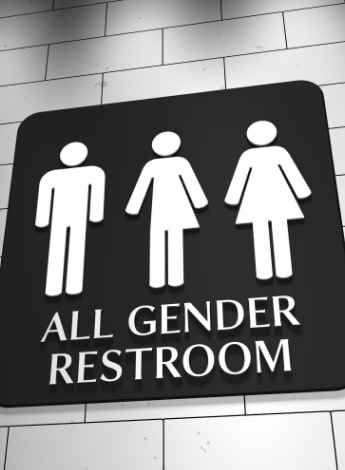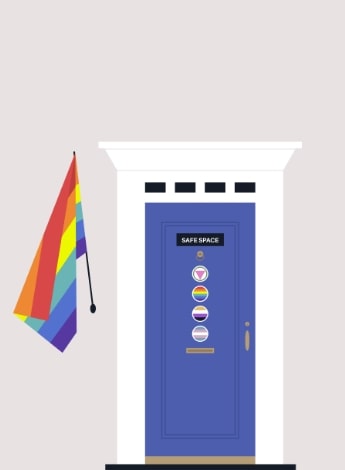
5 Facts about physiotherapy for the LGBTQIA+ community

Dr Megan Ross presents five discussion points about the challenges members of the LGBTQIA+ community face in accessing physiotherapy and how physiotherapists can provide care that is inclusive and affirming.
1. People with diverse genders and sexual orientations can experience barriers to physiotherapy

People who identify as lesbian, gay, bisexual, transgender, queer, intersex, asexual and other related identities (LGBTQIA+) can encounter assumptions, discrimination, discomfort and lack of knowledge or understanding when accessing physiotherapy (Ross & Setchell 2019).
These experiences can have profound impacts on health and wellbeing, including influencing decisions to delay or avoid necessary care.
When physiotherapists make assumptions about gender identity (cisnormativity) and/or sexual orientation (heteronormativity), patients are put in a position where they have to choose between disclosing (and therefore risking the therapeutic relationship or potential discrimination) and not disclosing (with a potential impact on care) (Ross & Setchell 2019).
Aspects of physiotherapy encounters may cause discomfort for people with diverse genders and sexual orientations.
In our study, members of LGBTQIA+ communities described discomfort about physical touch or undressing, observing bodies and disclosing diverse identities for fear of discrimination or refusal of care (Ross & Setchell 2019).
Participants described perceptions or fears of judgement for not fitting into socially constructed, normative gender conventions and fears about inadvertently being outed due to their anatomy.
2. Physiotherapists’ approaches to working with the LGBTQIA+ community vary

Physiotherapists approach gender identity and sexual orientation in three distinct ways and demonstrate varied knowledge and attitudes about working with patients who identify as LGBTQIA+ (Ross & Setchell 2023).
Some physiotherapists treat the whole person in context and consider the biological, psychological and social aspects (such as stigma and power imbalances) of LGBTQIA+ identities and experiences.
This approach demonstrates highly nuanced knowledge and understanding and is likely to result in patients feeling respected and celebrated for who they are and receiving the additional support required to achieve their goals.
Other physiotherapists take an equality approach and describe treating everyone the same, with little consideration of additional social factors.
This was the most common approach.
Many physiotherapists appeared not to intend to discriminate, make assumptions or stereotype but in the process inadvertently or implicitly minimised or erased LGBTQIA+ identities and experiences.
Gender identity and sexual orientation were positioned as potentially important aspects of a person but were separated as being outside of the remit of physiotherapy care.
The final approach was treating the body part, without consideration of how or why LGBTQIA+ identity may be relevant to physiotherapy practice (Ross & Setchell 2023).
This approach completely separated ‘biology’ from the biopsychosocial model and took a traditional biomedical approach, which may contribute to stigmatisation and marginalisation of people with LGBTQIA+ identities and experiences.
3. Inclusion of LGBTQIA+ content in Australian physiotherapy curricula is limited
In Australia, LGBTQIA+ content is included to a limited extent in university physiotherapy curricula.

Despite 62 per cent of Australian universities indicating that LGBTQIA+ content was included and 88 per cent indicating that it is relevant to physiotherapy, limited time and depth of coverage indicate a lack of perceived importance relative to other topics (Ross et al 2023).
In this way, Australian universities are maintaining the pervasive heteronormativity of the physiotherapy profession and are complicit in the ongoing health disparities between the LGBTQIA+ and heteronormative communities (Ross et al 2023).
In university curricula, LGBTQIA+ education is not often specifically addressed.
Instead, it is conceptualised broadly within cultural competency training, social determinants of health and health disparities (Ross et al 2023).
This generic approach to ‘diversity and inclusion’ and ‘cultural sensitivity’ is unlikely to facilitate nuanced understandings of unique, population-specific health needs.
The literature strongly highlights the importance of including LGBTQIA+ specific content in physiotherapy education (eg, Primeau et al 2022, Brenner et al 2022).
We found that physiotherapy students who had greater exposure to people with LGBTQIA+ identities and experiences had fewer heteronormative attitudes and beliefs, greater awareness and more inclusive attitudes about working with the LGBTQIA+ community (Brenner et al 2022).
4. LGBTQIA+ inclusive practice requires normativity to be challenged

To provide inclusive and affirming care, it is important to acknowledge the disparities experienced by the LGBTQIA+ community and how that plays out in healthcare.
Recognising and addressing the impact of discrimination and trauma experienced by the community is crucial to understanding fears and discomfort about accessing physiotherapy.
More than one in two LGBTQIA+ individuals experience discrimination when accessing healthcare and are likely to be cautious or have pre- existing fears or concerns before engaging with a new service.
Physiotherapists can demonstrate inclusivity, safety and acceptance in a number of ways. Avoiding cis and heteronormative assumptions (ie, that all people are cisgender and heterosexual) can positively influence experiences of physiotherapy.
Enhancing representation and visibility within clinical settings (ie, displaying images of diverse bodies and identities within the clinic) can promote a sense of belonging and acceptance (Ross & Setchell 2019), along with providing opportunities for patients to accurately describe themselves on intake forms.
Aspects of physiotherapy such as the use of mirrors, observing the body, physical touch and gendered terms for anatomy may be uncomfortable or traumatic for some members of the LGBTQIA+ community (Aird et al 2023) and physiotherapists can navigate this sensitively by obtaining informed, continual consent and providing alternatives that the patient feels comfortable with.
5. Physiotherapists have the skills to provide patient-centred care for the LGBTQIA+ community
Physiotherapists learn patient-centred and biopsychosocial approaches to working with clients that can be drawn on to work inclusively with the LGBTQIA+ community.
Individuals who identify as LGBTQIA+ may be seeking physiotherapy for reasons unrelated to their gender identity or sexual orientation.

In these cases, specific treatment or management of presenting conditions may not be influenced by LGBTQIA+ identity but physiotherapists may require additional skills and knowledge to sensitively navigate consultations.
This may include modified approaches to observation and touch, language for anatomy, interpersonal communication and privacy and confidentiality.
Physiotherapists can enhance their provision of inclusive and effective care for LGBTQIA+ clients by creating welcoming environments, employing inclusive communication and committing to ongoing professional development.
Establishing a culture of respect and acceptance within clinical settings is crucial, supported by education on the unique needs of LGBTQIA+ communities.
Inclusive practices may involve using intake forms that allow self-identification of gender, displaying visual indicators of acceptance and providing all-gender facilities (Ross & Setchell 2019).
Respectful communication, using appropriate pronouns, avoiding assumptions and adapting gendered terminology when necessary are key elements of inclusive physiotherapy.
Open and non-judgemental communication fosters trusting therapeutic relationships, enabling patients to disclose information comfortably and to express their concerns (Ross & Setchell 2019).
Quick links:
>> Dr Megan Ross (she/her) APAM is a physiotherapist, chair of the APA’s LGBTQIA+ advisory panel and a postdoctoral research fellow at the University of Queensland. Megan’s research focuses on access to healthcare and LGBTQIA+ experiences of healthcare.
© Copyright 2025 by Australian Physiotherapy Association. All rights reserved.





